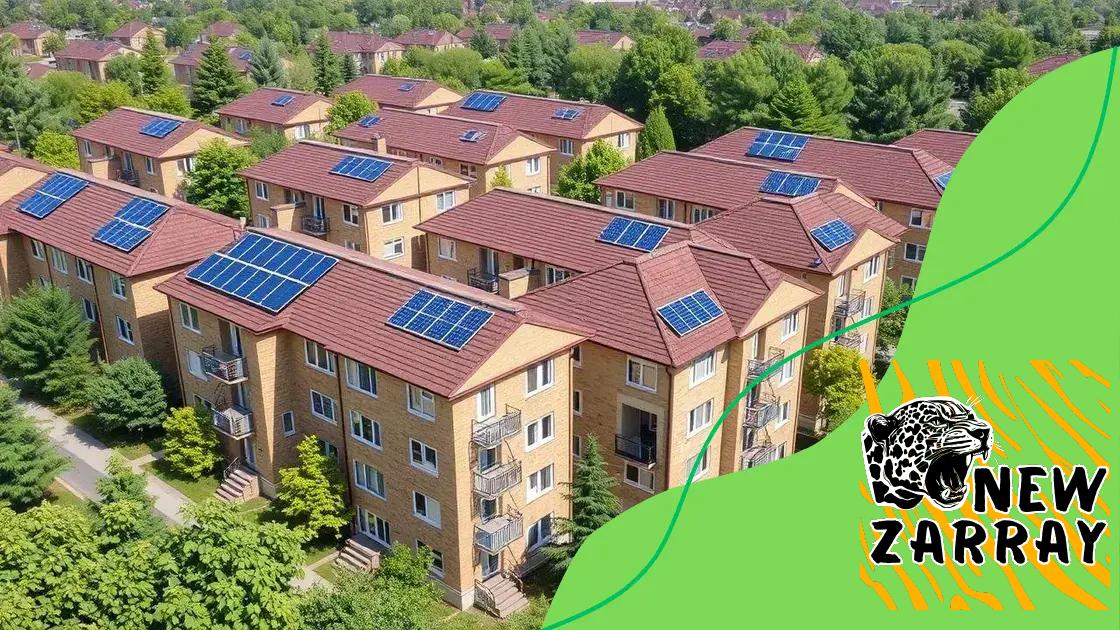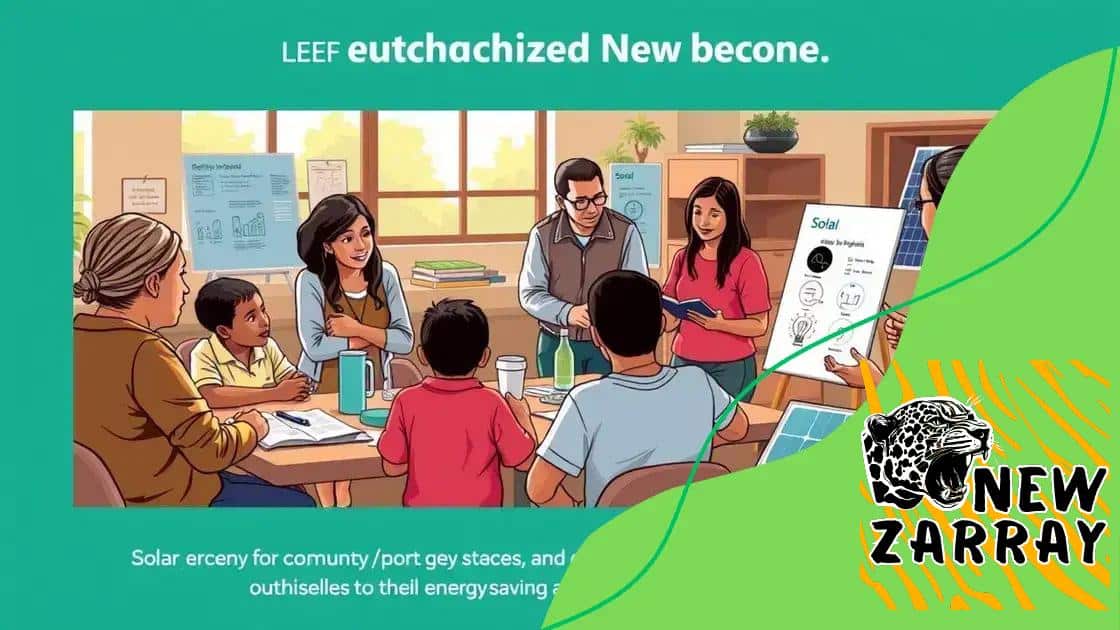Renewable energy incentives for public housing

Renewable energy incentives for public housing lower utility costs, enhance energy efficiency, and provide financial assistance for families, promoting sustainable living environments in communities.
Renewable energy incentives for public housing offer a unique opportunity to enhance energy efficiency and reduce costs for low-income families. Have you ever considered how these initiatives can transform living conditions? Let’s explore their benefits.
Understanding renewable energy incentives
Understanding renewable energy incentives can help residents of public housing save money and improve energy efficiency. These incentives are designed to encourage the use of clean energy sources, making it easier for families to transition from traditional energy. By incentivizing households, the government aims to promote a healthier environment and reduce energy bills.
What are Renewable Energy Incentives?
Renewable energy incentives are financial benefits provided by the government or other organizations. These can include tax credits, rebates, and grants aimed at reducing the cost of transitioning to renewable energy sources like solar and wind. They are crucial for making sustainable energy affordable for everyone, especially those in public housing.
Types of Incentives
- Tax credits designed to lower personal income tax bills.
- Rebates providing cash back for energy-efficient upgrades.
- Grants available for the installation of renewable technology.
- Low-interest loans to finance renewable energy projects.
Tax credits play an essential role, allowing residents to deduct expenses related to renewable energy from their taxable income. This can lead to significant savings. Rebates also provide immediate relief by returning a portion of the costs of purchases related to renewable energy systems, making them more accessible.
Furthermore, grants can cover the entire cost of installation for qualifying households, while low-interest loans offer a feasible way to finance energy-efficient improvements. These incentives ultimately contribute to lowering utility costs and fostering a more sustainable living environment.
Impact on public housing affordability
The impact of renewable energy incentives on public housing affordability is significant. These incentives can help lower living costs for families who need it most. When energy bills decrease, households have more funds available for other essential needs.
Lower Energy Costs
One of the most direct benefits is the reduction in energy expenses. Public housing residents often face high utility bills, which can take a large portion of their income. With access to renewable energy incentives, families can switch to more affordable energy sources.
Increased Financial Stability
- Residents can allocate saved funds to other necessities.
- Lower bills contribute to improved quality of life.
- Financial flexibility allows for better budgeting.
This shift not only decreases the monthly expenses but also encourages responsible financial behavior. When families spend less on energy, they can invest in education, healthcare, and other critical areas that improve their living conditions.
Additionally, by increasing the accessibility of renewable energy technologies, public housing becomes more attractive. This can lead to higher occupancy rates and stability within communities. More families choosing to live in energy-efficient houses enhances neighborhood appeal.
Ultimately, the broader economic impact is also notable. When many households benefit from these programs, it can lead to significant positive changes in the local economy. Increased disposable income contributes to local businesses and stimulates growth.
Government programs supporting energy efficiency

Government programs that support energy efficiency are vital for promoting renewable energy incentives, especially in public housing. These initiatives are designed to provide financial assistance and guidance to families looking to improve their energy use. By participating in such programs, residents can lower their utility bills and contribute to a more sustainable environment.
Types of Government Programs
Different programs exist to cater to various needs. Some focus on delivering financial assistance, while others offer educational resources. Understanding these options is essential for maximizing benefits.
Available Resources
- Subsidies for renewable energy installations.
- Free energy audits to identify efficiency improvements.
- Training programs on energy-saving practices.
- Partnerships with local non-profits for direct assistance.
Government programs may offer subsidies that help cover the costs associated with installing solar panels or upgrading insulation. Free energy audits allow households to pinpoint areas where they can save energy and money. Additionally, training programs enable families to learn about energy-saving practices that can be implemented in their daily lives.
By collaborating with local non-profits, these government initiatives create a robust network of support for families. Residents can access direct assistance for their energy needs, ensuring a smoother transition to energy-efficient solutions. The goal is to empower low-income families, making the journey toward sustainability accessible for everyone.
Furthermore, community outreach efforts increase awareness of available resources. When families are informed about these government programs, they are more likely to take action and benefit from renewable energy incentives. In doing so, they contribute to a larger movement that promotes greener living.
Case studies of successful implementations
Examining case studies of successful implementations of renewable energy incentives reveals how effective these programs can be in public housing settings. These real-world examples showcase the positive impact of transitioning to renewable energy and highlight the benefits families experience when they participate.
Example 1: Solar Power in Urban Housing
In a large urban housing complex, the installation of solar panels significantly reduced electricity costs for residents. Thanks to governmental subsidies, many families accessed solar energy without upfront costs. As a result, residents reported savings of up to 30% on their monthly utility bills.
Example 2: Energy Efficient Retrofits
Another case involved a public housing initiative that focused on energy-efficient retrofits. This program provided funding for improved insulation, energy-efficient windows, and upgraded heating systems. Families who participated enjoyed warmer homes during winter and cooler living spaces in summer, leading to an enhanced quality of life.
- Reduced energy consumption by 25% in participating homes.
- Decreased reliance on fossil fuels.
- Increased property value for the housing units.
These upgrades, funded by state and local programs, empowered families to not only save on utility bills but also invest in their homes. The community noticed an overall increase in satisfaction among residents, illustrating how renewable energy incentives can create a more comfortable living environment.
Moreover, another project in rural areas successfully implemented wind turbines for energy generation. This initiative demonstrated how a mix of renewable technologies could provide a holistic energy solution, enhancing energy security for low-income families. When the wind farm began operation, residents enjoyed lower electricity costs, further supporting the need for expanded renewable energy access.
Future of renewable energy in public housing
The future of renewable energy in public housing looks promising as communities increasingly recognize the importance of sustainability. With growing concerns about climate change, many cities are committing to reducing their carbon footprint, and public housing is at the forefront of this movement.
Emerging Technologies
Innovative technologies are set to reshape how energy is utilized in public housing. Advancements in solar panels, energy storage solutions, and smart grids will make renewable energy even more efficient.
Increased Funding Opportunities
Government and private sector investments are predicted to rise. Funding for renewable energy projects is likely to expand, providing more resources for retrofitting existing buildings and constructing new energy-efficient homes.
- Grants for solar and wind energy projects.
- Subsidies for energy-efficient appliances.
- Low-interest loans for deep energy retrofits.
Such funding will allow public housing authorities to implement major upgrades that enhance energy efficiency. This means more households will have access to affordable and clean energy solutions.
The emphasis on community engagement will also play a critical role moving forward. As residents become more involved in decision-making processes, their input can lead to tailored solutions that meet their specific energy needs. Programs that educate families about energy conservation and efficiency will empower them to engage actively.
Furthermore, incorporating renewable energy into public housing can stimulate job creation within local communities. The need for installation, maintenance, and support for these technologies can lead to new job opportunities, enhancing local economies and ensuring a sustainable future.
FAQ – Frequently Asked Questions about Renewable Energy Incentives in Public Housing
What are renewable energy incentives?
Renewable energy incentives are programs that provide financial assistance, rebates, or tax credits to encourage the use of clean energy sources, helping families reduce energy costs.
How do these incentives benefit public housing residents?
These incentives help lower utility bills, making energy more affordable, and improve living conditions by promoting the use of efficient energy systems.
What types of technologies are supported by these incentives?
Incentives typically support solar panels, wind turbines, energy-efficient appliances, and home retrofits for better insulation and heating.
Where can families find more information about available programs?
Families can check with local government websites, housing authorities, and community organizations to learn about available renewable energy incentives and programs.





